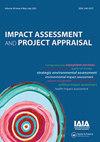Advancing the consideration of ecological connectivity in environmental assessment – Part 2 of the special issue
IF 1.9
4区 社会学
Q3 ENVIRONMENTAL STUDIES
引用次数: 0
Abstract
Despite a rapidly growing body of research about ecological connectivity, studies explicitly examining and advancing its inclusion and consideration in environmental assessment (EA) have remained surprisingly sparse. The primary purpose of this special issue is to compile and catalyse research that explicitly links connectivity and EA practice, showcasing the work of researchers and practitioners that recognizes the significance of connectivity and addresses knowledge gaps. We are pleased to introduce the second part of this special issue, featuring three additional papers that delve deeper into the topics and insights presented in the first 7 articles and first editorial. The first part of this special issue, published in November 2022 (IAPA vol. 40, no. 6), emphasized the need for studies that combine EA and ecological connectivity and aimed to promote interdisciplinary and cross-sectoral collaboration and to improve current EA practices. It started with an overview of current practices and common issues regarding the treatment of connectivity in EA, drawing on a global survey of EA actors (Patterson et al. 2022b), followed by national overviews about urban planning in Sweden (Karlsson and Bodin 2022) and road planning in Brazil (Oliveira Gonçalves et al. 2022), as well as the EA process in Canada (Patterson et al. 2022a) and in the United Kingdom (Kor et al. 2022). Subsequent papers zoomed into specific cases that (1) explicitly incorporated connectivity assessments in the EA process across scales and EA tiers ranging from project-level environmental impact assessments to strategic environmental assessments (Cumming and Tavares 2022), (2) developed and applied strong quantitative approaches to model habitat connectivity for certain target species in EAs (Kor et al. 2022), and (3) explored the contribution of mitigation measures to the connectivity of ecological networks for amphibians (Clevenot et al. 2022). The first editorial summarized the findings of these studies in terms of challenges, uncertainties, and opportunities associated with quantifying, assessing, and mitigating impacts on connectivity as part of the EA process (Torres et al. 2022). It laid out the need for systemic changes and further research efforts for better integration of connectivity into EA practice. Some of the challenges identified refer to the accurate quantification of the effects of development projects on connectivity and the use of the results. For instance, they point to the need to avoid the Fallacy of Stressed Systems and the Shifting Baseline Syndrome to prevent an underestimation of impacts on connectivity, to the danger of mis-use of connectivity assessments to mask or ‘compensate’ for habitat loss, and to the need to set up and follow through with monitoring for sufficiently long time periods. In the planning and regulatory perspective, the editorial highlighted that it is crucial to raise awareness and explicitly consider connectivity in national planning and in strategic environmental assessments and that clear roles and responsibilities among EA stakeholders must be established to substantiate accountability. These efforts would contribute to the advancement of evidencebased EA and enhance the decision-making process. The second part of the special issue aims at improving the understanding of connectivity analysis in EA phases that were examined less closely in the first part, i.e., the comparison of alternative designs and the phase of mitigation and compensation. It expands applied knowledge by presenting good examples of connectivity analysis in EA through an examination of case studies. These articles also expand the geographical scope of the special issue, with studies from Brazil and Australia and a comparison of case studies from countries such as the United Kingdom, Canada, Spain, and Sweden. In the first article, Sales Rosa et al. (2023) emphasize the importance of connectivity assessments for planning mitigation strategies and compensation schemes, such as biodiversity offsets. Their study models and compares ecological connectivity for large mammals in a mining region located in the Brazilian Atlantic rainforest at present and for future scenarios with the implementation of biodiversity offsets. The findings indicate that offsets can improve ecological connectivity by providing alternative habitats for affected species and emphasize the importance of carefully planning the locations of restoration areas to maximize their contributions to connectivity and habitat quality. To improve the treatment of connectivity in EA, the study recommends the incorporation of biodiversity monitoring, the modelling of offset areas for conservation and restoration, and a thorough analysis of project alternatives. The second article by Fung et al. (2023) from Australia makes two major contributions. It first provides an overview of spatially explicit studies in EA that assessed the effects of linear infrastructure on IMPACT ASSESSMENT AND PROJECT APPRAISAL 2023, VOL. 41, NO. 5, 330–332 https://doi.org/10.1080/14615517.2023.2239586推进环境评价中生态连通性的考虑——特刊之二
尽管关于生态连通性的研究迅速增长,但明确检查和推进其在环境评估(EA)中的纳入和考虑的研究仍然少得惊人。本期特刊的主要目的是汇编和促进明确将连通性和EA实践联系起来的研究,展示认识到连通性重要性并解决知识差距的研究人员和实践者的工作。我们很高兴地介绍本期特刊的第二部分,其中包括三篇额外的论文,这些论文更深入地探讨了前7篇文章和第一篇社论中提出的主题和见解。这期特刊的第一部分,于2022年11月出版(IAPA第40卷,no. 10)。(6)强调有必要将生态环境评估与生态连通性结合起来进行研究,旨在促进跨学科和跨部门合作,并改进当前的生态环境评估实践。本文首先概述了EA中连通性处理的当前实践和常见问题,借鉴了对EA参与者的全球调查(Patterson等人,2022b),然后概述了瑞典(Karlsson和Bodin 2022)和巴西(Oliveira gonalves等人,2022)的城市规划国家概况,以及加拿大(Patterson等人,2022a)和英国(Kor等人,2022)的EA过程。随后的论文聚焦于具体的案例(1)明确地将连通性评估纳入EA过程中,从项目级环境影响评估到战略环境评估(Cumming and Tavares 2022);(2)开发并应用了强大的定量方法来模拟EA中某些目标物种的栖息地连通性(Kor et al. 2022)。(3)探讨了缓解措施对两栖动物生态网络连通性的贡献(Clevenot et al. 2022)。第一篇社论总结了这些研究的发现,包括与量化、评估和减轻作为EA过程一部分的连通性影响相关的挑战、不确定性和机遇(Torres et al. 2022)。它提出了系统变革和进一步研究工作的必要性,以便更好地将连接性集成到EA实践中。确定的一些挑战涉及发展项目对连通性的影响的准确量化和结果的使用。例如,他们指出需要避免压力系统谬论和转移基线综合症,以防止低估对连通性的影响,指出滥用连通性评估来掩盖或“补偿”栖息地丧失的危险,并指出需要建立并坚持足够长时间的监测。从规划和监管的角度来看,社论强调,在国家规划和战略环境评估中提高认识并明确考虑连通性至关重要,必须建立环境影响评估利益相关者之间明确的角色和责任,以证实问责制。这些努力将有助于推进基于证据的环境评估,并加强决策过程。特刊的第二部分旨在增进对第一部分中没有仔细研究的环境评估阶段的连通性分析的理解,即替代设计与缓解和补偿阶段的比较。它通过对案例研究的考察,展示了EA中连接性分析的好例子,从而扩展了应用知识。这些文章还扩大了特刊的地理范围,包括来自巴西和澳大利亚的研究,以及来自英国、加拿大、西班牙和瑞典等国的案例研究的比较。在第一篇文章中,Sales Rosa等人(2023)强调了连通性评估对规划缓解策略和补偿方案(如生物多样性补偿)的重要性。他们的研究模拟并比较了巴西大西洋热带雨林矿区大型哺乳动物的生态连通性,以及实施生物多样性抵消的未来情景。研究结果表明,补偿可以通过为受影响物种提供替代栖息地来改善生态连通性,并强调仔细规划恢复区域的位置以最大限度地提高其对连通性和栖息地质量的贡献的重要性。为了改善EA中连通性的处理,该研究建议结合生物多样性监测,为保护和恢复偏移区域建模,以及对项目替代方案进行彻底分析。来自澳大利亚的Fung et al.(2023)的第二篇文章做出了两个主要贡献。 它首先概述了EA中空间明确的研究,这些研究评估了线性基础设施对影响评估和项目评估的影响,2023,VOL. 41, NO. 1。5,330 - 332 https://doi.org/10.1080/14615517.2023.2239586
本文章由计算机程序翻译,如有差异,请以英文原文为准。
求助全文
约1分钟内获得全文
求助全文
来源期刊

Impact Assessment and Project Appraisal
ENVIRONMENTAL STUDIES-
CiteScore
4.60
自引率
22.70%
发文量
52
期刊介绍:
This is the international, peer-reviewed journal of the International Association for Impact Assessment (IAIA). It covers environmental, social, health and other impact assessments, cost-benefit analysis, technology assessment, and other approaches to anticipating and managing impacts. It has readers in universities, government and public agencies, consultancies, NGOs and elsewhere in over 100 countries. It has editorials, main articles, book reviews, and a professional practice section.
 求助内容:
求助内容: 应助结果提醒方式:
应助结果提醒方式:


